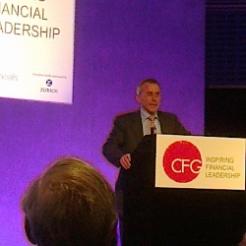Co-founder of CFG Andrew Hind looked to the future at the group’s 25th anniversary conference yesterday, and warned that the sector must be careful not to let new models like social enterprise, CICs and CIOs saturate the sector and confuse the public about what charity actually stands for.
Hind, who is also ex-CEO of the Charity Commission and current editor of Charity Finance magazine, delivered a speech that looked back over CFG’s quarter-century existence, regaling the audience with the achievements the group has made in that time – while warning that further and quite different challenges now await it, and indeed the sector, heading into the future.
One such challenge is that new ventures should be allowed to “breathe new life” into the sector, without blurring the boundaries so that the public no longer knows what a charity stands for.
“I think this is a real worry,” Hind told the audience. “In fact, we may not have to go anywhere near another 25 years into the future to see the idea of ‘charity’ distorted in the minds of the public. It’s a real danger, and we have to be careful.”
Pension liability risks
There were five other topics that Hind highlighted as potentially having a huge impact on the voluntary sector over the next 25 years.
“The issue of pension liabilities is truly a frightening sight – there are massive black holes all over the place,” he said. “The question is, is this just a temporary result of current circumstances with bond yields being so low and the impact that has on predicted liabilities of defined-benefit pension schemes, or is it actually a threat to the long-term survival of some of our biggest charity brand names?”
Hind pointed out that if liabilities had to crystallise today, the sector would be left with a large number of insolvent big-name charities. “If you look at the liabilities in pension schemes of the top 50 charities,” he said, “and you take the industry-accepted multiplier for an insurance company buy-out of those liabilities, you find that the deficits on those schemes in aggregate exceed the unrestricted funds of the parent charities.”
Data revealed recently via Hind’s own investigation for Charity Finance shows that almost 80 per cent of the top 50 charities have such deficits on their pension schemes.
Other main concerns
Improving the quality of public service delivery, and making sure that charities that receive a large percentage of income from statutory means did not lose sight of their core charitable purpose, was another of Hind’s concerns.
The other three were whether to amend the long-established governance model in light of the push to pay trustees and put executives on charity boards; whether the recent trend for mergers was truly about collaboration or was just a Darwinian survival struggle; and the impact that social finance may have with regards to the danger of charities being left “in hock” to commercial lenders.









